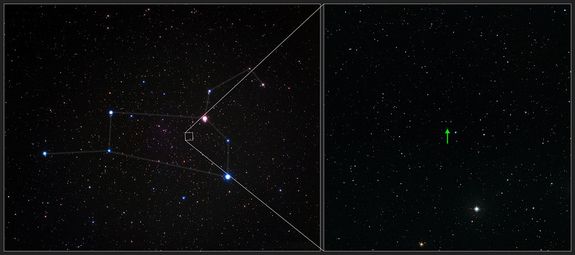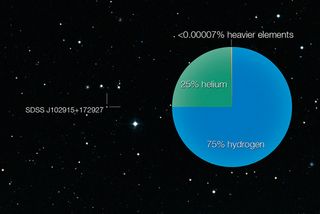Impossible Star Defies Astronomers' Theories

A primordial star at the outer edges of our Milky Way galaxy may upset current theories of star formation in the universe. The star simply shouldn't exist since it lacks the materials astronomers have long thought necessary for low-mass stars to form, scientists say.
The star, with the somewhat cumbersome name of SDS J102915+172927, hails from the beginning of the universe. At 13 billion years old, it formed from the death of the first generation of stars. (The universe itself is estimated to be about 13.7 billion years old.)
An analysis of the star's makeup reveals that it formed relatively quickly after the supernova-explosion deaths of a few of the short-lived original stars. [Video: Star That Shouldn't Exist]

After the Big Bang
After the Big Bang, thought to give rise to our universe, space was awash in hydrogen and helium, with traces of lithium. The first stars that formed created heavier elements (called "metals" by astronomers) through nuclear fusion burning in their cores.
Then, the violent, explosive deaths of the first generation spread elements such as carbon, oxygen, and nitrogen across the universe, seeding it for the longer-lasting stars we see today.
Using simulations and observations of other low-mass stars, astronomers have determined the minimum levels of various elements so that a star has enough mass to pull together under gravity. But the composition of the primordial star weighs in far below those numbers.
Sign up for the Live Science daily newsletter now
Get the world’s most fascinating discoveries delivered straight to your inbox.
"There is a theory of star formation that states that a low-mass star, such as this one, cannot form if the metals in the material are less than a certain amount," Elisabetta Caffau, of the Zentrum fur Astronomie der Universitat in Germany, told SPACE.com by email.
According to the theory, carbon and oxygen are needed to cool the material so the gas can collapse into a star.
But the newfound star lacks a sufficient amount of these two elements.
"A star so poor in metals as SDSS J102915+172927, without a strong enhancement of carbon and oxygen, was not expected to exist," Caffau said.
The search for the stars
Over the last decade, Caffau and her team have been scanning the heavens in search of extremely metal-poor (EMP) stars.
"These stars are old relics of the primitive universe," Caffau said. "Their chemical composition holds the fossil record of the interstellar medium composition at the time they were formed." [The Strangest Things in Space]
Using a computer to pick out hundreds of thousands of possible targets from an all-sky scan called the Sloan Digital Sky Survey, the team began examining twenty of the best candidates with the European Southern Observatory's Very Large Telescope in Chile.
"These stars are usually very far away, and as a consequence faint," Caffau explained. This makes them a challenge to spot.
But the telescope proved up to the task.
Finding others
Though the newfound star is unusual, the researchers don't think it's necessarily unique. They intend to continue surveying other possible targets with the hopes of finding others like it. Locating more EMPs will help astronomers further constrain the limits of star formation.
The first generation of stars was made of hydrogen and helium, with traces of lithium. The new find is very similar. Only a smattering of heavy elements separates this star from the universe's original creations.
At least one earlier supernova must have provided the early star with its tiny percentage of heavy elements. Before this find, astronomers had thought stars such as SDSS J102915+172927 would need to wait longer before forming, for more supernova star deaths to provide the materials needed.
A star like this demonstrates otherwise.
"Our observation shows that at this very primitive chemical composition, low mass stars were forming," Caffau said. "The issue is to understand how many. "This may have a bearing on the subsequent evolution of galaxies."
The research was published in the Aug. 31 online issue of the journal Nature.
This story was provided by SPACE.com, sister site to LiveScience. Visit SPACE.com for the latest in space science and exploration news on Twitter @Spacedotcom and on Facebook.













